Chapter 12 Self and social cognition development
社会认知理论(纯干货)
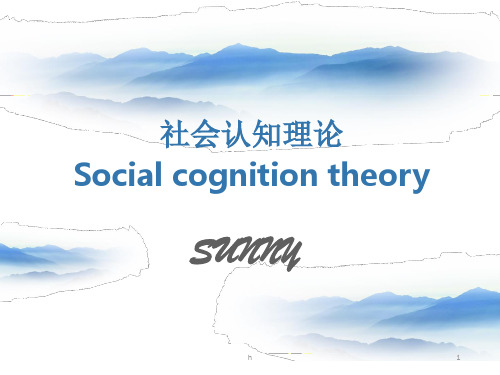
矫正。并按信息加工的模式对观察学习进行了分析,认为观察学习是
由4个相关联的子过程组成的即注意过程、保持过程、产出过程、动
机过程。
注意过程:在观察时将心理资源开通的过程,它决定着观察者选择什么样的示范
原型;
保持过程:对示范活动的保持,要对示范活动进行保持就必须以符号的形式把它
表象化,从而保留在记忆中;
Academy of management Review, 1989, 1h4(3): 361-384.
3
SCT主要应用于心理学、教育和人际沟通等领
域,认为个人的知识获取部分与在社交互动、经验、
外部媒体情境下观察到的别人行为有直接关系。
这一理论指出,当人们观察到榜样(model)执行 的行为和行为的后果,他们记住的事件序列,使用这 些信息来指导后续行为。榜样也可以促使他们学会观 众参与的行为。换句话说,人们可以不用仅仅通过自 身尝试学习新行为,而是通过复制别人的行为习得新 知识或行为,根据行为和行为产生的结果所得到的奖 励或惩罚,人们选择复制榜样的行为。
enwikipediaorgwikisocialcognitivetheory12四自我效能感selfefficacy自我效能感是个体对自己与环境发生相互作用效验性的一种自我判断自我效能是一个人对自己能否在一定水平上完成某一活动所具备的能力判断信念或主体自我把握与感受自我效能感强的人能对新的问题产生兴趣并全力投入其中能不断努力去战胜困难而且在这个过程中自我效能也将会不断的得到强化与提高
有的事件图式影响对新信息的加工。
h
17
社会认知的阶段
编码:即对社会性信息给予充分地注意和感知,并选取有意义的信息。 解释:将获得的信息与已有的知识经验(图式、原型等)进行比较,
国外记忆和认知课件ch12

The Propositional Calculus
Cognition 7e, Margaret Matlin
Chapter 12
Deductive Reasoning
An Overview of Conditional Reasoning
Chapter 12
Deductive Reasoning
An Overview of Conditional Reasoning
the propositional calculus antecedent consequent
Cognition 7e, Margaret Matlin
Chapter 12
The Confirmation Bias
The Standard Wason Selection Task
confirmation bias—people would rather try to confirm a hypothesis than try to disprove it
Variations on the Wason Selection Task
Confirmation Bias
Variations on the Wason Selection Task
(continued)
Griggs and Cox (1982)—drinking age example
If a person drinks an alcoholic drink, then they must be over the age of 21 years old.
Cognition 7e, Margaret Matlin
Social Cognitive Theory

Running head: SOCIAL COGNITIVE THEORYSocial Cognitive Theory, basic concepts and understandingJohn InmanOregon State UniversityDepartment of Education Graduate SchoolMasters in Adult Education CohortSocial Cognitive Theory, basic concepts and understandingSocial Cognitive TheoryF. Pajares (1996) In Social Foundations of Thought and Action, Albert Bandura (1986) wrote that individuals possess a self-system that enables them to exercise a measure of control over their thoughts, feelings, and actions. This self-system houses one's cognitive and affective structures and includes the abilities to symbolize, learn from others, plan alternative strategies, regulate one's own behavior, and engage in self-reflection. It also plays a prominent role in providingreference mechanisms and a set of sub functions for perceiving, regulating, and evaluating behavior, which results from the interplay between the self-system and external environmental sources of influence. As such, the self-system serves a self-regulatory function by providing individuals with the capability to alter their environments and influence their own actions.Bandura felt that the behavioral models did not adequately explain how adults learned and that important psychological processes had been overlooked or only partially studied. The most notable finding that prompted his work was that peoplecould learn new actions merely by observing others perform them and this did not fit into the behavioral model of learning. The enactive model that promoted leaning by performing tasks and keeping or discarding the learning based on whether the task was successful was far too limiting, particularly in complex work where to simply do the task to learn it is virtually impossible.Albert Bandura (1977, p. 22) states, "Learning would be exceedingly laborious, not to mention hazardous, if people hadto rely solely on the effects of their own actions to inform them what to do. Fortunately, most human behavior is learned observationally through modeling; from observing others oneforms an idea of how new behaviors are performed, and on later occasions this coded information serves as a guide for action. Because people can learn from example what to do, at least in approximate form, before performing any behavior, they arespared needless errors."Of important note to the discussion of Social Cognitive Theory is the concept of latent action based on observation. A learner may very well not use what is observed for weeks, months, or indeed years. Enactive learning or practice will help solidify the learning from vicarious observational learning.Theorists and or AuthorsTheorists primarily include Bandura and Zimmerman with others to include but not limited to Rosethal, Berger, and Schunk.Social Cognition Key Learning ConceptsThe foundation of Bandura's Social Cognitive Theory is reciprocal interactions. The major break from behavioraltheorists came with Bandura's model of triadic reciprocility. In this model, Bandura postulated that the person, the behavior, and the environment were all inseparably entwined to create leaning in an individual. The next quote by Bandura states this quite clearly.Albert Bandura (1986, p. 18) In the social cognitive view people are neither driven by inner forces nor automatically shaped and controlled by external stimuli. Rather, human functioning is explained in terns of a model of triadic reciprocility in which behavior, cognitive and other personal factors, and environmental events all operate as interacting determinants of each other.Schunk (2000) According to social cognitive theory, observing a model does not guarantee learning or later abilityto perform the behaviors. Rather, models serve informational and motivational functions by providing information about probable consequences of actions and affecting observers' motivation to act accordingly. Factors influencing learning and performanceare developmental status of learners, prestige and competence of models, vicarious consequences to models, goals, outcome expectations, and perceived self-efficacy.Schunk (2000, p. 108) Self-efficacy refers to personal beliefs about one's capabilities to learn or perform actions at designated levels. Albert Bandura (1997) Self-efficacy is abelief about what one is capable of doing; it is not the same as knowing what to do. In gauging efficacy, individuals assesstheir skills and their capabilities to translate those skills into actions.Theorist understandingIn Pajares (1996), the description by the author ofBandura's understanding of social cognitive theory and its components is as clear as I can be on what he may understand ofthis body of work. "How individuals interpret the results oftheir performance attainments informs and alters their environments and their self-beliefs, which in turn inform and alter their subsequent performances. This is the foundation of Albert Bandura's (1978 & 1986) conception of reciprocal determinism, the view that (a) personal factors in the form of cognition, affect, and biological events, (b) behavior, and (c) environmental influences create interactions that result in a triadic reciprocality. Because personal agency is sociallyrooted and operates within sociocultural influences, individuals are viewed both as products and as producers of their own environments and of their social systems.Albert Bandura (1986) considered self-reflection the most uniquely human capability, for through this form of self-referent thought people evaluate and alter their own thinking and behavior. These self-evaluations include perceptions ofself-efficacy, that is, "beliefs in one's capabilities to organize and execute the courses of action required to manage prospective situations" (Albert Bandura 1997, p. 2). Thesebeliefs of personal competence affect behavior in several ways. They influence the choices individuals make and the courses of actions they pursue. Efficacy beliefs help determine how much effort people will expend on an activity, how long they will persevere when confronting obstacles, and how resilient theywill prove in the face of adverse situations-the higher the sense of efficacy, the greater the effort, persistence, and resilience.ReferencesBandura, Albert (1977). Social Learning Theory. Englewood Cliffs, N.J.: Prentice-Hall.Bandura, Albert (1978). The self-system in reciprocal determinism. American Psychologist, 33, 344-358.Bandura, Albert (1986). Social Foundations of Thought and Action: A social cognitive theory. Englewood Cliffs, N.J.: Prentice Hall.Bandura, Albert (1997). Self-efficacy: The exercise of control. New York: Freeman.Pajares, F. (1996). Self-efficacy beliefs in academic settings. Review of Educational Research, 66(4), 543-578. Retrieved February 7, 2001 from the World Wide Web:/~whuitt/psy702/files/selfeff.html Schunk, Dale H. (2000). Social Cognitive Theory. In Kevin M. Davis (Ed.), Learning theories: an educational perspective (3rd ed., p. 118). Upper Saddle River, New Jersey: MERRILL, an Imprint of Prentice-Hall.。
Chapter 12 Motivation and Emotion
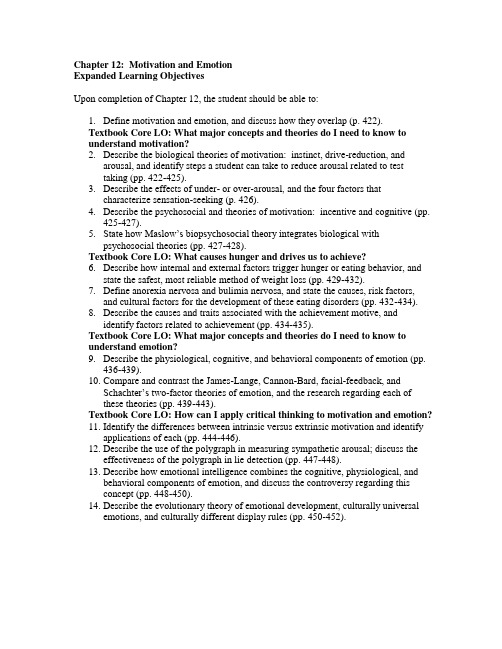
Chapter 12: Motivation and EmotionExpanded Learning ObjectivesUpon completion of Chapter 12, the student should be able to:1.Define motivation and emotion, and discuss how they overlap (p. 422).Textbook Core LO: What major concepts and theories do I need to know tounderstand motivation?2.Describe the biological theories of motivation: instinct, drive-reduction, andarousal, and identify steps a student can take to reduce arousal related to testtaking (pp. 422-425).3.Describe the effects of under- or over-arousal, and the four factors thatcharacterize sensation-seeking (p. 426).4.Describe the psychosocial and theories of motivation: incentive and cognitive (pp.425-427).5.State how Maslow’s biopsychosocial theory integrates biological withpsychosocial theories (pp. 427-428).Textbook Core LO: What causes hunger and drives us to achieve?6.Describe how internal and external factors trigger hunger or eating behavior, andstate the safest, most reliable method of weight loss (pp. 429-432).7.Define anorexia nervosa and bulimia nervosa, and state the causes, risk factors,and cultural factors for the development of these eating disorders (pp. 432-434).8.Describe the causes and traits associated with the achievement motive, andidentify factors related to achievement (pp. 434-435).Textbook Core LO: What major concepts and theories do I need to know tounderstand emotion?9.Describe the physiological, cognitive, and behavioral components of emotion (pp.436-439).pare and contrast the James-Lange, Cannon-Bard, facial-feedback, andSchachter’s two-factor theories of emotion, and the research regarding each ofthese theories (pp. 439-443).Textbook Core LO: How can I apply critical thinking to motivation and emotion?11.Identify the differences between intrinsic versus extrinsic motivation and identifyapplications of each (pp. 444-446).12.Describe the use of the polygraph in measuring sympathetic arousal; discuss theeffectiveness of the polygraph in lie detection (pp. 447-448).13.Describe how emotional intelligence combines the cognitive, physiological, andbehavioral components of emotion, and discuss the controversy regarding thisconcept (pp. 448-450).14.Describe the evolutionary theory of emotional development, culturally universalemotions, and culturally different display rules (pp. 450-452).。
Implicit Self-esteem and Social Identity AND

ANTHONY GREENWALD, G. AND MAHZARIN R . construct validity
William James (1890)defined self-esteem as a self-feeling that is determined by a comparison between the actual self and the ideal self. Following James's definition of self-esteem, standard self-report measures of self-esteem ask respondents either to rate themselves on a variety of specific traits (Marsh, 1986; Pelham and Swann, 1989; Wells and Marwell, 1976), or to indicate how they feel about themselves globally (Rosenberg, 1979). However, research has not supported James's formulation because self-esteem does not appear to be the product of honest appraisal of one's traits and abilities (Rosenberg, 1979) or one's social identity (Crocker and Major, 1989). Rather, research indicates that the higher one's self-esteem, the greater the self-enhancing bias (see Brown, 1991, for review). Consequently, psychologists have debated extensively whether selfesteem causes self-appraisals or vice versa (Brown, 1993; Pelham and Swann, 1989), whether self-esteem leads to discriminatory behavior or vice versa (Abrams and Hogg, 1988), whether people are motivated towards accuracy or positivity in their self-concepts (Brown, 1991; Shrauger, 1975; Swann, 1990), and why, if having high self-esteem is not based on accurate self-appraisals, anyone would have low self-esteem (Baumeister, 1993). What psychologists have only recently considered is that the correspondence between self-esteem measures and self-enhancing behaviors suggests that selfesteem measures may be capturing the wrong construct (Baumeister, Tice, and Hutton, 1989): the motive to present a positive attitude toward self rather than genuine self-esteem. A positivity bias provides no threat to the construct validity of self-esteem measures (i.e., their ability to measure the self-esteem construct). Whether such biases arise from positive feelings toward the self (Brown, 1993) or cognitive beliefs about the self (Markus and Wurf, 1986), they are a reflection of the level of positive self-regard. Such an automatic positivity bias can be interpreted as a manifestation of implicit self-esteem. Greenwald and Banaji defined implicit selfesteem as "the introspectively unidentified (or inaccurately identified) effect of the self-attitude on evaluation of self-associated and self-dissociated objects" (1995, p. 11). This tendency to overestimate one's traits and abilities is understood as a spillover of positive affect from the self to objects associated with the self. Because most people have positive self-affect (Banaji and Prentice, 1994; Greenwald, 1980; Taylor and Brown, 1988), implicit self-esteem effects usually
社会认知理论(纯干货)

内隐态度:是个体对事物所持的积极或消极的认知、情感 或反应,由不自觉的以往经验或不能归因于以往某一确定 经验所引起。 内隐自尊:是人自发的无意识的对自己评价倾向。 内隐刻板印象是调节着某个社会范畴所具有的属性中无法 内省辨认(或不能准确辨认)的过去经验的痕迹。(刻板 印象是一种涉及知觉者的关于某个人类群体的知识、观念 与预期的认知结构)如内隐性别刻板印象、内隐种族刻板 印象的研究。⋅
Environment
与环境、行为和认知构成相互影响的
关系。
例如,观察到的行为可以改变一 个人的思维方式(认知)。同样,环境 也可能会影响以后的行为,就像一个 父亲的心态(认知)将决定孩子成长的
Individual
Reference:
Behavior
环境。
/wiki/Social_cognitive_theory 陈俊.社会认知理论的研究进展[J].社会心理科学,2003,22(12):59-62.
(四)事件图式Fra bibliotek人们在某种情境下所发生事件的有序组织的信息。即许多 事情均涉及一系列典型的活动次序,犹如戏剧或电影的脚本中所 列出的一个又一个场景。比如我们在餐厅吃饭,去医院看医生, 都是属于一种事件图式,事件图式将影响人们对事件的记忆,原 有的事件图式影响对新信息的加工。
社会认知的阶段
编码:即对社会性信息给予充分地注意和感知,并选取有意义的信息。 解释:将获得的信息与已有的知识经验(图式、原型等)进行比较,
自我效能感的来源: (1)实践成败经验
(2)替代性经验
(3)言语的劝导 (4)身心状态
社会图式
社会认知就是一个形成社会图式,并且已形成的社会认 知又会对我们今后的认知产生影响的过程。其实社会图式是根据 认知心理学中图式的概念发展而来,我们知道图式就是对获得的 信息进行组织和加工后在人脑中形成的认知系统。社会图式就是
英语 self-recongnition 200词
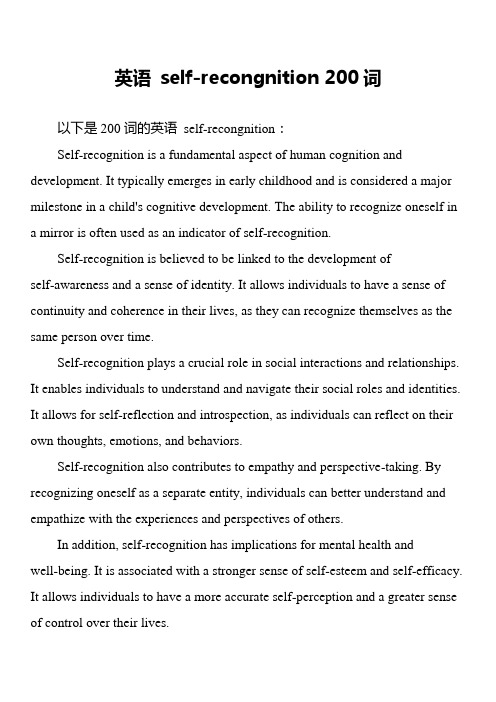
英语self-recongnition 200词以下是200词的英语self-recongnition:Self-recognition is a fundamental aspect of human cognition and development. It typically emerges in early childhood and is considered a major milestone in a child's cognitive development. The ability to recognize oneself in a mirror is often used as an indicator of self-recognition.Self-recognition is believed to be linked to the development ofself-awareness and a sense of identity. It allows individuals to have a sense of continuity and coherence in their lives, as they can recognize themselves as the same person over time.Self-recognition plays a crucial role in social interactions and relationships. It enables individuals to understand and navigate their social roles and identities. It allows for self-reflection and introspection, as individuals can reflect on their own thoughts, emotions, and behaviors.Self-recognition also contributes to empathy and perspective-taking. By recognizing oneself as a separate entity, individuals can better understand and empathize with the experiences and perspectives of others.In addition, self-recognition has implications for mental health andwell-being. It is associated with a stronger sense of self-esteem and self-efficacy. It allows individuals to have a more accurate self-perception and a greater sense of control over their lives.。
chapter 12
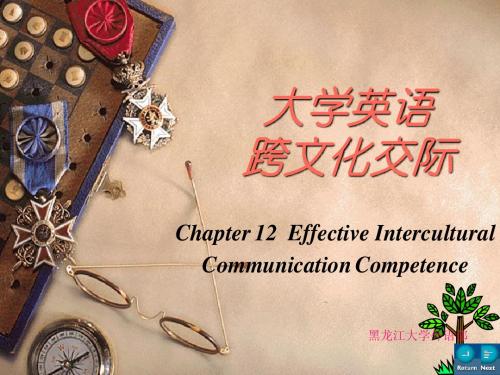
Chapter 12 Effective Intercultural Communication Competence
* Knowledge: Four aspects involved are: information—about people/context/norms of appropriateness; culture-general information—about intercultural communication process culture-specific information—about a particular culture, the culture's uniqueness, customs information—about one's own culture * Motivations: emotional associations people have in intercultural communication Two aspects involved are: Feelings: emotional or affective states in intercultural communication, such as happiness, sadness, etc. Intentions: guides one's choice in intercultural communication. * Actions: Actions refer to the actual performance of those behaviors that are regarded as appropriate and effective.
Chapter 12 Effective Intercultural Communication Competence
社会认知 Social Cognition(中英文)
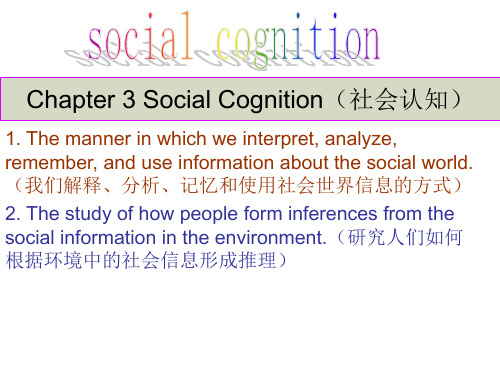
Framing effects
Framing effects(表述效应): Terms in which decision alternatives are framed often strongly influence people’s judgments.(各种决策方法表述的术语常常强烈地影响人们的判 断)One example is people’s risk-averse tendency(一个事例 是风险厌恶倾向). People’s risk-averse tendency: Whether a decision is presented in terms of the gains it will create or the losses that might be incurred influences people’s judgment(一个决策是否用它将产 生的收益来描述还是它将发生的损失来描述会影响人们的判断). Generally people become very cautious when alternatives are phrased in terms of their risks, but they are far more likely to take chances when alternatives are framed in terms of gains. (一般来说,当方案根据风险来表述时,人们变得更加谨慎;用 收益来表述时,人们非常可能去尝试)
Main terms
confirmatory hypothesis testing(证实的假设检验); conjunction error(联合错误); planning fallacy(计划错误); counterfactual thinking(反事实思维); rational and intuitive processing(理性和直觉加工); magical thinking(虚幻的思 维). Social inference(社会推理); statistical information and case history information(统计信息和个案历史信息); illusory correlation(错觉相关); framing effect(参照效应); moodcongruent memory(情绪相符的记忆); mood-dependent memory(情绪依赖的记忆); mental contamination(心理污染); affect infusion model(情感结合模型); thought suppression(思想 压抑); attention, encoding, retrieval(注意、编码和提取; selffulfilling prophecies(自我实现的预言); information overload (信息超载); representativeness heuristic(代表性启发); availability heuristic(可得性启发); priming(启动); simulation heuristic(模拟启发); anchoring and adjustment heuristic(锚定和调整启发).
(整理)Chapter 12 Language and the Brain
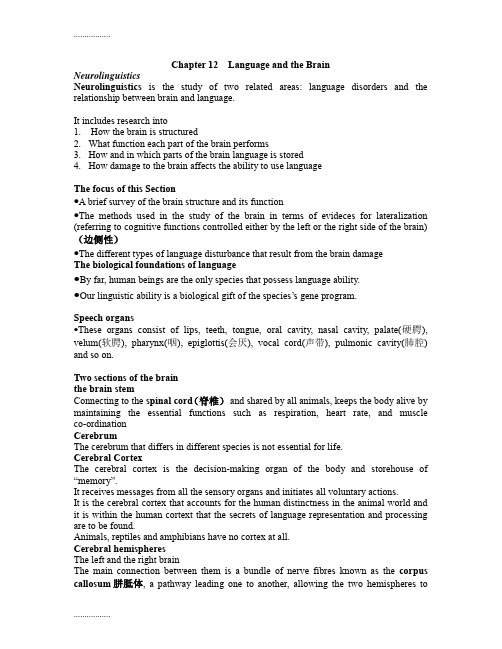
Chapter 12 Language and the BrainNeurolinguisticsNeurolinguistics is the study of two related areas: language disorders and the relationship between brain and language.It includes research into1. How the brain is structured2.What function each part of the brain performs3.How and in which parts of the brain language is stored4.How damage to the brain affects the ability to use languageThe focus of this Section•A brief survey of the brain structure and its function•The methods used in the study of the brain in terms of evideces for lateralization (referring to cognitive functions controlled either by the left or the right side of the brain)(边侧性)•The different types of language disturbance that result from the brain damageThe biological foundations of language•By far, human beings are the only species that possess language ability.•Our linguistic ability is a biological gift of the species’s gene program.Speech organs•These organs consist of lips, teeth, tongue, oral cavity, nasal cavity, palate(硬腭), velum(软腭), pharynx(咽), epiglottis(会厌), vocal cord(声带), pulmonic cavity(肺腔) and so on.Two sections of the brainthe brain stemConnecting to the spinal cord(脊椎)and shared by all animals, keeps the body alive by maintaining the essential functions such as respiration, heart rate, and muscle co-ordinationCerebrumThe cerebrum that differs in different species is not essential for life.Cerebral CortexThe cerebral cortex is the decision-making organ of the body and storehouse of “memory”.It receives messages from all the sensory organs and initiates all voluntary actions.It is the cerebral cortex that accounts for the human distinctness in the animal world and it is within the human cortext that the secrets of language representation and processing are to be found.Animals, reptiles and amphibians have no cortex at all.Cerebral hemispheresThe left and the right brainThe main connection between them is a bundle of nerve fibres known as the corpus callosum胼胝体, a pathway leading one to another, allowing the two hemispheres tocommunicate with each other.The left hemisphere seems to do better in language, rhythmic perception, temporal-order judgments and mathematical thinkingThe right hemispheres show distinct abilities and responsibilities, complex mental activities such as language do not always fall neatly into one hemisphere or the other but involve the coordinated functioning of both hemispheres.4 lobes of cerebral cortexRevisionThe structure of the human brain•Three parts in human brain•(1) brain stem (脑干): keeps the body alive by maintaining the essential functions such as respiration, heart rate, and muscle co-ordination.•(2) cerebellum (小脑): responsible for controlling body equilibrium and regulating the function of voluntary movements.•(3) cerebrum (大脑): important for language psychology•The surface of the cerebrum: cerebral cortex (大脑皮层) is the information processing and decision-making organ and the biological basis of human psychology.The structure of the human brainThe importance of cerebral cortex•It is the cerebral cortex that accounts for the human distinctness in the animal world and it is within the human cortex that the secrets of language representation and processing are to be found.Major mental functions under the control of each cerebral hemisphere•Such localization of cognitive and perceptual functions in a particular hemisphere of the brain is called brain lateralization.Methods for the study of the brain and evidences for lateralization•Autopsy studies 验尸•Methods to the study of the brainSAT 阿米妥纳试验CT scanning 计算机化轴向层面X射线摄影法PET 阳电子发射X线体层摄影法MRI 磁共振成像fMRI 功能磁共振成像•Methods to examine the behaviour associated with the brainingDichotic listening 双耳分听试验Split brain studies 裂脑试验Autopsy studies (验尸)It has been and continues to be an important tool in the understanding of the brain. Method:to examine the brain after the patient’s death in order to find the relationshipbetween the area of brain damage and the type of disorder the patient displayed while alive.A woman with epilepsy 癫痫,羊角风Methods to the study of the brainMethods to examine the behaviour associated with the brain5.Right ear advantage:6.Most people report the stimuli heard in the right ear more accurately than that in the left one.7.How to explain such a phenomenon?8. e.g. the dichotic listening research9.(双耳分听试验)10.The majority of normal human beings have speech located primarily in the left hemisphere.Methods to examine the behaviour associated with the brain•The cerebral hemispheres are connected by the corpus callosum (胼胝体).•What may happen when the brain is split surgically?•Information from the left side of the body is received only by the right side of the brain and vice versa.•Right hemisphere can understand and comprehend information, but it is mute.•Split brain studies (裂脑试验): the experiments that investigate the effects of surgically severing the corpus callosum on cognition.Language center and aphasia•Verbal information processing is realized mainly through a number of language centers situated in the left hemisphere.•1) Broca’s area (布罗卡区) [anterior language area]•It lies in the frontal part of the left brain.•2) Wernicke’s area (韦尼克区) [posterior language area]•It leans behind Broca’s area.•3) Angular gyrus (角形脑回)•It lies further behind the Wernicke’s area.•It is by this part that human beings match a spoken form with a perceived object, name the objects and comprehend the written language.Aphasia(失语症)•Aphasia refers to a number of acquired language disorders due to the cerebral lesions (大脑损伤) caused by vascular problems (血管问题), a tumour, an accident and so on. •The study of aphasia is by far the most important tool in the investigation of language in the brain.Broca’s aphasia(布罗卡失语症)•Paul Broca, French doctor, 1861•Any lesion of the anterior part of the left hemisphere will lead to speech production difficulties.•(expressive aphasia, non-fluent aphasia)•e.g. Yes… ah…Monday…Dad and Peter…hospital… and ah… Wednesday, nine o’clock…and… ah doctors … two…er…teeth…yah.Symptoms: poor articulation•express a single word at a time•omit articles, conjunctions, and other functional words•omit grammatical inflections (-- telegraphic speech)Wernicke’s aphasia(韦尼克失语症)•Carl Wernicke, German physician, 1874•Any lesion in left cortex behind the central sulcus (脑沟) will lead to speech comprehension deficits.•(receptive aphasia, fluent aphasia)•e.g. Colorless green ideas are sleeping furiously.Symptoms:fast and fluent speechgood intonation, pronunciationinappropriate contenteven nonsensedifficulty in comprehensionAcquired dyslexia(习得性失读症)•Acquired dyslexia: damage in and around the angular gyrus of the parietal lobe (顶叶) often causes the impairment of reading and writing ability.•Two types of acquired dyslexia:•1. phonological dyslexia (拼音性失读症): patients can only read words that they have seen before. They seem to have lost the ability to use spelling-to-sound rule.•2. Surface dyslexia (浅层诵读困难): patients seem unable to recognize words as wholes but must process all words through a set of spelling-to-sound rules.Acquired dyslexia(习得性失读症)Psycholinguistics•Psycholinguistic research methodsField workExperimental methods•Linguistics and language processingPhonetics and phonologyMorphological processingSyntax•Psycholinguistic modelingPsycholinguistics•In the1940s, the term psycholinguistics came into being.•The publication of Psycholinguistics: A Survey of Theory and Research Problems (1954) (by Charles Osgood and Thomas Sebeok)•A milestone, marking the birth of the new science•Psycholinguistics is the study of psychological states and mental activity associated with the use of language. It concerns the representation of language in the mind, the planning, production, perception and comprehension of speech, and language acquisition. The focus of this sectionWhat do psycholinguists do?Explore:11.how language is represented and processed in the mind12.How the concepts and principles are used in different levels of language processing13.How speech is producedPsycholinguistic research methods•Field work✓spoonerisms 首音互换•Experimental methods✓Lexical Decision✓The priming experiment✓Timed-reading experiments✓Eye movement experiments✓Event-related potential experiment11.2.1 Psycholinguistic research methods•Language production is a process of conversion from thoughts to speech.•Easy or difficult to study? Why?•Difficult to study.•It is almost impossible to observe the internal ideas or the involved processes. •Now, language production can only be studied through indirect evidence:•1) the analysis of pauses in spontaneous speech•2) the analysis of instances of speech errors (slips of the tongue)Field work: Pauses or silence14.Around 40%-50% of an average spontaneous utterance consists of pauses.15.Types of pauses: breathing & hesitation16.Reasons for pauses: (Inaugural address)17.1) to take a breath18.2) to organize his thought19.3) to find a proper word20.4) to wait to see the effect of his speech on the listener21.Finding: Speakers do not normally pause between clauses; they pause inside them.22.Conclusion: There is overlapping in the planning and production of clauses.23.That is, we begin to plan the next clause while still uttering the present one. Spoonerisms斯本内现象首音互换24.William A. SpoonerSpeech Errorsslips of tonguePhonological errors primarily in content words, not in grammatical morphemes, such as –s, or –edWords and lexical morphemes (used for the construction of new words, such as black in the compound blackbird and –ship in friendship) may be interchanged, but grammatical morphemes may not be;The intonation contour remains unchanged as in the intended utterances, even when the words are disorderedErrors tend to occur at only one linguistic level per utterance. That is when a person clearly says the wrong word, the sentence is syntactically, prosodically, and phonologically intact.All these slips of the tongue provide evidence that the morpheme, rather than the word, is the fundamental building block of English sentence production.Field work: Speech errors•e.g.•You have hissed my mystery lectures. I saw you fight a liar in the back quad. In fact, you have tasted the whole worm. (Dr. William Spooner)Eight types of speech errors (Psychology of Language, D. W. Carroll, 1986)•石头把玻璃没打碎。
同步测试
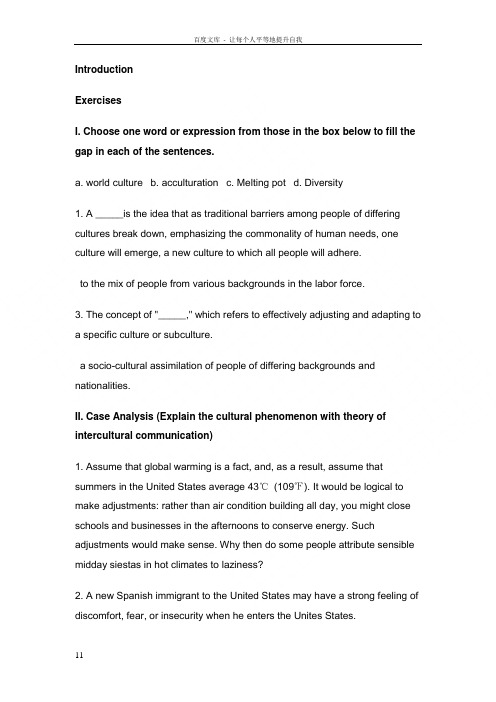
IntroductionExercisesI. Choose one word or expression from those in the box below to fill the gap in each of the sentences.a. world cultureb. acculturationc. Melting potd. Diversity1. A _____is the idea that as traditional barriers among people of differing cultures break down, emphasizing the commonality of human needs, one culture will emerge, a new culture to which all people will adhere.to the mix of people from various backgrounds in the labor force.3. The concept of "_____," which refers to effectively adjusting and adapting toa specific culture or subculture.a socio-cultural assimilation of people of differing backgrounds and nationalities.II. Case Analysis (Explain the cultural phenomenon with theory of intercultural communication)1. Assume that global warming is a fact, and, as a result, assume that summers in the United States average 43℃(109℉). It would be logical to make adjustments: rather than air condition building all day, you might close schools and businesses in the afternoons to conserve energy. Such adjustments would make sense. Why then do some people attribute sensible midday siestas in hot climates to laziness?2. A new Spanish immigrant to the United States may have a strong feeling of discomfort, fear, or insecurity when he enters the Unites States.3. Budweiser advertised to three regional subgroups: in California, Texas, and the Southwest. Advertisements aimed at Spanish-speakers of Mexican heritage featured cowboys and cactus; in the Northeast, advertisements aimed at Puerto Ricans featured cityscapes and salsa music; and the Florida, advertisements aimed at Cubans featured palm trees, cigars, and bananas. Each advertisement featured differently accented Spanish andnational-origin-appropriate music.III. Answer the following questionWhat are the key strategies for effective intercultural communication?Chapter I CultureExercisesI. Choose one word or expression from those in the box below to fill the gap in each of the sentences.a. Cultureb. Subgroupsc.“Wanna-be” behavior identity1.____ is a learned set of shared interpretations about beliefs, values,and norms, which affect the behavior of a relatively large group.2.____ resembles a culture in that it usually encompasses a relativelylarge number of people and represents the accumulation of generations of human striving.3.____, although also part of the dominant culture, are groups with whichthe dominant culture does not agree and with which it hascommunicating problems.4.____ refers to an individual who imitates the behavior of a group he orshe desires to belong to.5.____refers to one’s sense of belonging to a particular culture or ethnicgroup.II. Case Analysis (Explain the cultural phenomenon with theory of intercultural communication)A person may be a member of drama club, but later lose interest and hence give up membership in the group.III. Answer the following questions1. What are the characteristics of culture?2. What are the characteristics of cultural identity?Chapter II Cultural DynamicsExercisesI. Choose one word or expression from those in the box below to fill the gap in each of the sentences.a. Enculturationb. Separation and segregationc. Integrationd. Assimilatione. Marginalizationf. Honeymoon1. ________is the first stage of the culture shock where everything is new and exciting.2. ________refer to maintaining one’s original culture and not participating in the new culture.3. ________is the socialization process you go through to adapt to your society.4. ________takes place when individuals become an integral part of the new culture while maintaining their cultural integrity.5. _________is the degree to which an individual relinquishes an original culture for another. And the result is that people lose their previous culture.deculturation refers to losing one’s cultural identity and not having any psychological contact with the larger society.II. Case Analysis (Explain the cultural phenomenon with theory of intercultural communication)1. An international student in a U.S. grocery may be asked, "paper or plastic?" The student knows what paper is and what plastic is, but don’t understand the question.2. Liming, a Chinese student, just began his study in a university in the United States. He experienced skin eruption, and he craved "home cooking".III. Answer the following questions1. What are the possible results of acculturation?2. What are the differences between enculturation and acculturation?3. What is the reverse culture shock?Chapter III CommunicationExercisesI. Choose one word or expression from those in the box below to fill the gap in each of the sentences.a.Contextb. sourcec. Encodingd. Noisee. Feedback1. The ________ is the person with an idea he or she desires to communicate.is the process of putting an idea into a symbol.refers to anything that distorts the message the source encodes.refers to that portion of the receiver response of which the source has knowledge and to which the source attends and assigns meaning.is the environment in which the communication takes place and which helps define the communication.II. Answer the following questionsare the characteristics of communication?2. What is the relationship between communication and culture?3. What are the components of communication?ChapterⅣIntercultural CommunicationExercisesI. Choose one word or expression from those in the box below to fill the gap in each of the sentences.Communication b. Cross-cultural communicationcommunication d. Interracial communicationto communication between people of the same race but different ethnic backgrounds.when the sender and the receiver exchanging messages are from different races that pertain to different physical characteristics.typically used to refer to the study of a particular idea or concept within many cultures. The goal of such investigations is to conduct a series of intracultural analyses in order to compare one culture to another on the attributes of interest.to communication between people whose cultural perceptions and symbol systems are distinct enough to alter the communication event.II. Case Analysis (Explain the cultural phenomenon with theory of intercultural communication)Xiao LI and Xiao Wang were colleagues. Xiao LI gave a lot of help to Xiao Wang financially and socially. Recently Xiao LI would get married. But he forgot inviting Xiao Wang to attend his wedding. Later Xiao Wang got information about Xiao LI’ wedding and sent RMB 500 Yuan to Xiao LI.?III. Answer the following questionHow do you describe the western ethics?ChapterⅤCultural ValuesExercisesI. Choose one word or expression from those in the box below to fill the gap in each of the sentences.a. Worldviewb. Religionc. Power distanced. Uncertainty avoidancee. individualistwith a culture’s most fundamental beliefs about its place in the cosmos, beliefs about God, and beliefs about the nature of humanity and nature.2. __________refers to belief in and reverence for a supernatural power or powers regarded as creator and governor of the universe.measures the extent to which the less powerful members of organizations and institutions (like the family) accept and expect that power is distributed unequally.with a society’s tolerance for uncer tainty and ambiguity; it ultimately refers to man’s search for Truth.5. In the _______culture, the interest of the individual prevails over the interests of the group.II. Case Analysis (Explain the cultural phenomenon with theory of intercultural communication)1. The essence of the design of Chinese Garden is the harmony of nature and architect. This belief permeates in every aspect of Chinese culture.2. In Germany, there is a society that relies on rules, laws and regulations. Students expect their teachers to be experts who have all the answers. In the workplace, there is an inner need to work hard. Germany wants to reduce its risks to the minimum and proceed with changes step by step.III. Answer the following questions1. Could you describe peopl e’s attitudes toward human nature in different cultural value systems according to Kluckhohn and Strodtbeck’s value orientations?2. Could you explain people’s attitudes toward the relationship between man and nature in different cultural value systems according to Kluckhohn and Strodtbeck’s value orientations?ChapterⅥCulture’s Influence on PerceptionExercisesI. Choose one word or expression from those in the box below to fill the gap in each of the sentences.a. Interpretationb. selectionc. balanced. Needse. Sensationrefers to attaching meaning to sense data and is synonymous with decoding.2. Human perception is usually thought of as a three-step process of________, organization, and interpretation.3. Confucius encouraged a sense of __________and harmony.4. ________ affect what people are more likely to attend to.5. ______ is the neurological process by which people become aware of their environment.II. Case Analysis (Explain the cultural phenomenon with theory of intercultural communication)1. People in the United States frequently err in guessing the age of Japanese individuals, such as judging a Japanese college student in mid-20s to be only 14 or 15. Why?2. In 2002, the World Cup was held in Japan and Korea and people argued whether to ban eating dogs in Korea at that time, because western people believe dogs are friends not food.3. Chinese people both have fan and chai in one meal.III Answer the following questions1. How do you differentiate high-context culture and low-context culture?2. Can you explain why tea ceremony is an example of a high-context experience?ChapterⅦIntercultural Communication BarriersExercisesI. Choose one word or expression from those in the box below to fill the gap in each of the sentences.a. Ethnocentrismb. Prejudicec. Racismd. Back translationto negatively judging aspects of another culture by the standards of one’s own culture.to the irrational dislike, suspicion, or hatred of a particular group, race, religion, or sexual orientation.any policy, practice, belief, or attitude that attributes characteristics or status to individuals based on their race.is the concept of a written work translated to a second language, then having another person translate the work back to the first language to determine if the translations are equivalent.II. Case Analysis (Explain the cultural phenomenon with theory of intercultural communication)1. In 1997, a Danish woman left her 14-month-old baby girl in a stroller outsidea Manhattan restaurant while she was outside. Other diners at the restaurant became concerned and called New York City Police. The woman was charged with endangering a child and was jailed for two nights. Her child was placed in foster care. The woman and the Danish consulate explained that leaving children unattended outside cafes in common in Denmark.2. Sometimes parents will say to their children “we don't associate with people like that.” Or “be careful when you’re with them”.3. During World War II, the Allies had issued the Potsdam Ultimatum demanding the surrender of the Japanese military to end the war. Prime Minister Suzuki said, “The government does not see much value in it. All we have to do is Mokusatsu it.” but the word Mokusatsu can mean anything from “ignore” to “treat with silent contempt.” The Allies took it as the most offensive meaning.III. Answer the following questions1. What are the barriers to effective intercultural communication?2. What are the four reasons for the persistence of prejudice?3. What are five barriers that lead to translation problems?ChapterⅧVerbal Intercultural Communication (I)ExercisesI. Choose one word or expression from those in the box below to fill the gap in each of the sentences.a. Euphemismb. Contextualc. Tabood. Exactinge. Succinctvalues low amount of talk, or even silence. This style can be found inhigh-context culture with high uncertainty avoidance.use moderate amount of talk with low uncertainty avoidance, and is common in low-context culture.focuses on the speaker and role relationships. People with such communication style stress high power distance. This style is popular in collectivist and high-context culture.to some words or actions that are avoided by a particular group of people, or in certain culture for religious or social reasons.the act of substituting a mild, indirect, or vague term for one considered harsh, blunt, or offensive.II. Case Analysis (Explain the cultural phenomenon with theory of intercultural communication)1. An American businessman went to China for a business conference. To his surprise, the Chinese host company arranged two days of sightseeing and halfday of meeting. He was confused and believed that they were not professional. His Chinese counterpart thought that this American person was so hard to please.2. Tom was an exchange student from the United States. He was very popular boy when he was in American middle school. He found that when he praised Chinese girls, for example, “You are so sweet”, they didn’t even looked at him, and some of them even said: “No, I am not attractive at all”. He got confused, and wondered why these compliments didn’t work in China.III. Answer the following questionsWhat is the difference between direct and indirect communication style?ChapterⅨVerbal Intercultural Communication (Ⅱ)ExercisesI. Choose one word or expression from those in the box below to fill the gap in each of the sentences.a. results-orientedb. relationship-oriented1. Direct plan is favored by________ cultures with deductive patterns.2. In indirect plan with inductive pattern is favored by ________ culture.II. Case Analysis (Explain the cultural phenomenon with theory of intercultural communication)What does this table show?Country American Japanese ArabCultural objectives Provideinformation; Seekcommitments andactionSeek information;Offer proposalInformationexchangeOpening Direct to objective Offer thanks;ApologizePersonal greetingContent Factual; Plan ofaction Specific questions;Solicit informationBackgroundinformation; Indirectto subjectPersuasion Immediate gain orloss of opportunity Waiting Personalconnections; FutureopportunityNonverbal Urgency; Short Modesty; Minimize Lengthy; Elaboratecommunication sentences standing;Letterhead ormarks expression; Many signaturesClosing Affirmative; Specific request Maintain harmony; Future relationship Future relationship;personal greetingApplied cultural values Efficiency; Directness; Action Politeness; Indirectness; RelationshipStatus;Continuation;Acknowledgement;Wishes III. Answer the following questionWhat shall be considered in planning business messages?ChapterⅩNonverbal CommunicationExercisesI. Choose one word or expression from those in the box below to fill the gap in each of the sentences.a. Proxemicsb. Chronemicsc. Olfacticsd. Kinesicse. Nonverbal communicationf. Oculesics1. _______ refers to intentional use of nonspoken symbol to communicate a specific message.2. _______ is the study of communications sent by the eyes.3. _______ is the way we use fixed space and personal space.4. _______are behaviors such as gestures, body movements, facial expressions, and eye contact.5. _______ is the study of how people perceive and use time.6. _______ is the study of communication via smell.II. Case Analysis (Explain the cultural phenomenon with theory of intercultural communication)1. In India, there are elaborate rules about how closely members of each caste may approach other castes, and Arabs of the same sex do stand much closer than North Americans. North Americans in an elevator maintain personal space if the physical space permits it. An Arab entering an elevator may stand right next to another person and be touching even though no one else is in the elevator.2. In Thailand and Laos, it is rude for a stranger or acquaintance to touch a child on the top of the head because the head is regarded as the home of the spirit or soul. It is believed that a child’s spirit or soul is not strong enough t o be touched and has tendency to become ill if patted.III. Answer the following questions•What are the functions of nonverbal communication?•How do people from different cultures understand “silence”?ChapterⅪGlobal Social Customs and Business EtiquetteExercisesI. Choose one word or expression from those in the box below to fill the gap in each of the sentences.a.Bowing b.Handshake c.Tippingd.Gift giving e.Embracing f.Etiquettethe traditional way of greeting in Northeast Asian countries like Korea and Japan.a physical link between two persons.a fundamental part of service industries today and is a “reward” for services performed for guests and clients.some countries is an art and is considered an integral part of building intercultural professional and social relationship.is considered inappropriate as a form of greeting in the United States and China.to manners and behavior considered acceptable in social and business situation.II. Case Analysis (Explain the cultural phenomenon with theory of intercultural communication)People think American women are domineering and “loose”; Asian women are nonassertive and submissive; Latin American males are predatory.III. Answer the following questionWhat are eating style and continental eating style?ChapterⅫEffective Intercultural Communication CompetenceExercisesI. Choose one word or expression from those in the box below to fill the gap in each of the sentences.b. Supervisionc. The cognitive competenced. intercultural competencee. Operational competence1. The_____ refer to the ability to understand and adapt the target culture; in another word, it refers to the sensitivity to cultural diversity, . the ability to behave in an appropriate way and to adapt to one’s communic ation and interaction according to the context.2. _____ refers to setting goals, assigning tasks, and coordinating activities.3. _____ refers to coordinate, direct and guide the efforts of members of the organization to achieve organizational goals.4. _____ is that individuals’ capacity to express cognitive and affective experiences outwardly is shown through specific behaviors.of intercultural communication are the mental capacities of comprehension and ability to understand the meanings of various verbal and nonverbal codes.II. Answer the following questionExplain the term “intercultural communication competence” and its three components.。
尊严自尊、受尊重与尊重(Dignityselfrespect,respectandrespect)

尊严自尊、受尊重与尊重(Dignity self respect, respect andrespect)Dignity: self respect, respect and respectDignity is a right of the individual. Dignity consists of three elements: self-respect, respect and respect. As early as the beginning of last century, SkinnerThe author thinks seriously about the relationship between dignity and individual freedom, autonomy, and social control and justice. Later studies found that Zun ZunYan is also related to people's ability, strength, power and status in social interaction.Keywords dignity; self esteem; respect; respectClassification number B849:C91Dignity, like life, is important to all peopleThe. The first article in the Universal Declaration of human rights in 1948 wrote "people"Life and freedom, dignity and rights are equal, they FuThere is reason and conscience, and should be treated in the spirit of brotherhood".But in real life, dignity can be threatened by many threatsHurt。
非暴力沟通第十二章解决内心的冲突读后感
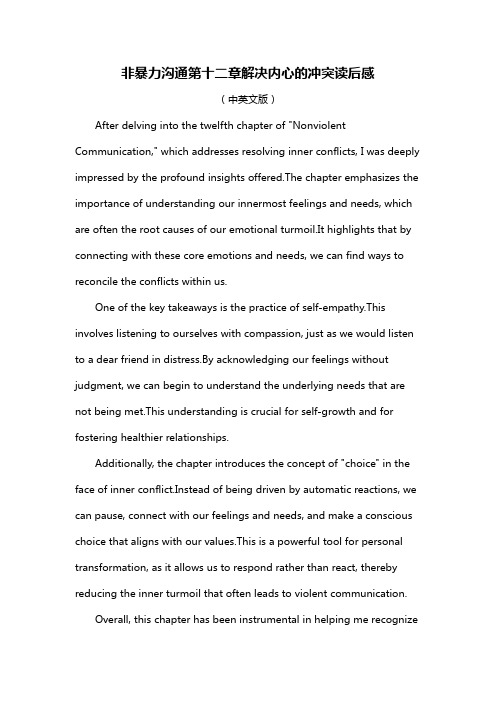
非暴力沟通第十二章解决内心的冲突读后感(中英文版)After delving into the twelfth chapter of "Nonviolent Communication," which addresses resolving inner conflicts, I was deeply impressed by the profound insights offered.The chapter emphasizes the importance of understanding our innermost feelings and needs, which are often the root causes of our emotional turmoil.It highlights that by connecting with these core emotions and needs, we can find ways to reconcile the conflicts within us.One of the key takeaways is the practice of self-empathy.This involves listening to ourselves with compassion, just as we would listen to a dear friend in distress.By acknowledging our feelings without judgment, we can begin to understand the underlying needs that are not being met.This understanding is crucial for self-growth and for fostering healthier relationships.Additionally, the chapter introduces the concept of "choice" in the face of inner conflict.Instead of being driven by automatic reactions, we can pause, connect with our feelings and needs, and make a conscious choice that aligns with our values.This is a powerful tool for personal transformation, as it allows us to respond rather than react, thereby reducing the inner turmoil that often leads to violent communication.Overall, this chapter has been instrumental in helping me recognizethe power of self-awareness and self-compassion.It encourages us to embrace our vulnerabilities and see them as opportunities for growth.By doing so, we can resolve inner conflicts peacefully and contribute to a more harmonious world through our communication.在深入阅读《非暴力沟通》第十二章,探讨解决内心冲突的问题之后,我深受其中深邃见解的启发。
社会认知SocialCognition中英文概要
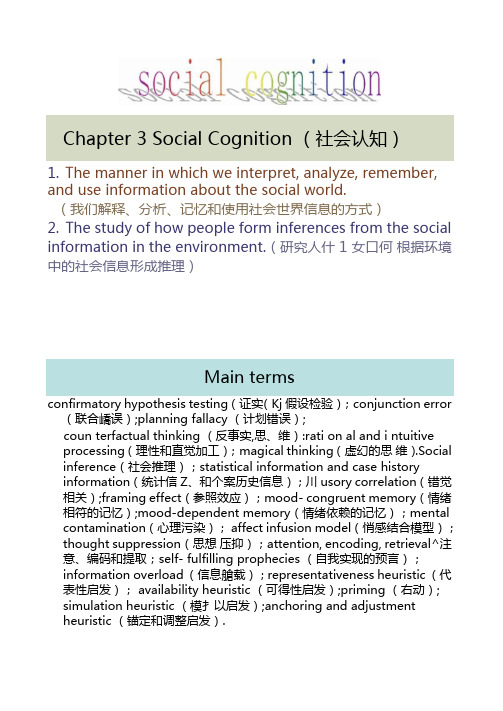
Chapter 3 Social Cognition (社会认知)1.The manner in which we interpret, analyze, remember, and use information about the social world.(我们解释、分析、记忆和使用社会世界信息的方式)2.The study of how people form inferences from the social information in the environment.(研究人什1 女口何根据环境中的社会信息形成推理)Main termsconfirmatory hypothesis testing (证实(Kj假设检验);conjunction error (联合嶠误);planning fallacy (计划错误);coun terfactual thinking (反事实,思、维):rati on al and i ntuitive processing (理性和直觉加工);magical thinking (虚幻的思维).Social inference(社会推理);statistical information and case history information(统计信Z、和个案历史信息);川usory correlation(错觉相关);framing effect(参照效应);mood- congruent memory(情绪相符的记忆);mood-dependent memory(情绪依赖的记忆);mental contamination(心理污染); affect infusion model(悄感结合模型);thought suppression(思想压抑);attention, encoding, retrieval^注意、编码和提取;self- fulfilling prophecies (自我实现的预言);information overload (信息艙载);representativeness heuristic (代表性启发); availability heuristic (可得性启发);priming (右动); simulation heuristic (模扌以启发);anchoring and adjustment heuristic (锚定和调整启发).I. Social inference (社会推理)Any social inference is composed of several steps: gathering information, deciding what information to use, and integrating the information into a judgment.(任何社会推理渚B 由几个步骤构成:收集信恵^ 决定使用什么信恵^ 整合信息形成判断。
亲密关系_Relation_部分25

information in a different o rder,and that’s enough to engender two different impressions (Asch, 1946). Our judgments of others are influenced by a p rimacy effect,a tendency for the first information we receive about others to carry spe-cial weight, along with our instant impressions and our stereotypes, in shaping our overall impressions of them.P rimacy effects provide one important indication of why first impressions matter so much: Right or wrong, our quick first judgments of others influence our interpretations of the later information we encounter. Once a judgment forms, it affects how we use the data that follow—often in subtle ways that are difficult to detect. John Darley and Paget Gross (1983) demonstrated this when they showed Princeton students a videotape that established the social class of a young girl named “Hannah.” Two different videos were prepared, and some people learned that Hannah was rather poor, whereas others found that she was pretty rich; she either played in a deteriorating, paved schoolyard and returned home to a dingy, small duplex or played on expansive, grassy fields and went home to a large, lovely house. The good news is that when Darley and Gross asked the participants to guess how well Hannah was doing in school, they did not assume the rich kid was smarter than the poor kid; the two groups both assumed she was getting average grades (see F igure 4.1 ). After that, however, the researchers showed the participants a tape of Hannah taking an aptitude test and doing an inconsistent job, answering some difficult questions correctly but blowing some easy ones. Everyone saw the same tape, but—and here’s the bad news—they interpreted it very differently depending on their impressions of her social class. People who thought that Hannah was poor cited her mistakes and judged her as performing b elow average whereas those who thought she was rich noted her successes and rated her as considerably b etter than average. Perceivers equipped with different preconceptions about Hannah’s social class interpreted the s ame sample of her behavior in very different ways and came to very different conclusions. And note how subtle this process was: They didn’t leap to biased assumptions about Hannah simply by knowing her social class, making an obvi-ous mistake that might easily be noticed. Instead, their knowledge of her social class lingered in their minds and contaminated their interpretations of her later actions. And they probably made their biased judgments with confidence, feeling fair and impartial. Both groups could point to a portion of her test performance—the part that fit their preconceptions—and feel perfectly justified in making the j udgments they did, never realizing that people with other first impressions were watching the same videotape and reaching contradictory conclusions.T hus, first impressions affect our interpretations of the subsequent infor-mation we encounter about others. They also affect our choices of the new information we seek. When we want to test a first impression about someone, we’re more likely to pursue information that will confirm that belief than to inquire after data that could prove it wrong. That is, people ordinarily display a c onfirmation bias:They seek information that will prove them right more often than they look for examples that would prove them wrong (Snyder, 1981). For instance, imagine that you’re instructed to interview a fellow student to find out if he or she is a sociable extravert, and you’re handed a list of possibleq uestions to ask. Some of the questions are neutral (e.g., “What are the good and bad points of acting friendly and open?”) but others are slanted toward eliciting introverted responses (“What do you dislike about loud parties?”) while still others are likely to get extraverted answers (“What do you do when you want to liven things up at a party?”). How would you conduct the inter-view? If you’re like most people, you’d select questions that probe for evidence that your expectation is correct.T hat’s just what happened when researchers asked some people to find out if a stranger was extraverted, but asked others to find out if the person was introverted (Snyder & Swann, 1978b). The two groups of interviewers adopted two very different lines of investigation, asking questions that made it likely that they’d get examples of the behaviors they expected to find. In fact, the interviews were so biased that audiences listening to them on tape actu-ally believed that the strangers really were rather extraverted or introverted, depending on the interviewers’ preconceptions.I ndeed, the problem with confirmatory strategies is that they elicit one-sided information about others that fits our preconceptions—and as a result, we too rarely confront unequivocal evidence that our first impressions are wrong. Thus, not only may we cling to snap judgments that are incorrect, but we may also think we’re right about others more often than we are (Ames et al., 2010). Indeed, most people are o verconfident in their beliefs about oth-ers, making more mistakes than they realize. Here’s an example. After you begin dating a new romantic partner, you’re likely to become confident thatyou understand his or her sexual history as time goes by. You’ll probably feel P e r c e i v e d A b i l i t y (g r a d e l e v e l )BackgroundInformation Achievement Test InformationFIGURE 4.1. Our preconceptions control our interpretations of information about others.People equipped with different expectations about the social class of a fourth-grade girl drew very different conclusions about her performance on an achievement test, although they all witnessed the very same performance. Those who thought they were watching a rich kid judged her to be performing an entire grade better than did those who thought they were watching a girl from a more modest background.Data from Darley & Gross, 1983.increasingly c ertain, for instance, that you know how many other lovers your partner has had, or whether or not he or she has a sexually transmitted infec-tion. Remarkably, however, you’re not likely to be as well-informed as you think. Studies at the University of Texas at Austin found that people could not estimate the risk that a new acquaintance was HIV-positive as well as they thought they could (Swann et al., 1995). They were overconfident when a new relationship began, and as the relationship developed, they only got w orse (Swann & Gill, 1997). With greater familiarity, they became more certain that they understood their new partners well, but their accuracy did not change (see F igure 4.2 ).S o, first impressions matter because the first things we learn (a) direct our attention to certain types of new information and (b) influence our interpre-tations of those new facts. The net result is that we do not process informa-tion about others in an unbiased, evenhanded manner. Instead, our existing notions, whether they’re simple stereotypes or quick first impressions, affect how we access and use the new data we encounter. We are usually unaware of how readily we overlook evidence that we could be wrong. We’re not tentative. Armed with only some of the facts—those that tend to support our case—we put misplaced faith in our judgments of others, being wrong more often than we realize.N ow, of course, we come to know our partners better with time and expe-rience. One of the hallmarks of intimacy is personal knowledge about a part-ner, and first impressions certainly change as people gain familiarity with each other (Kammrath et al., 2007). However—and this is the fundamental point I wish to make— e xisting beliefs are influential at every stage of a relationship. Even flimsy first impressions typically change less easily than they logically should because of the manner in which they influence subsequent thinking. And whatA c t u a l a n d E x p e c t e d A c c u r a c y (% c o r r e c t b e l i e f s )FIGURE 4.2. Accuracy and (over) confidence in developing relationships.At the beginning of their relationships, people felt that they knew more about the sexual histories of their new partners than they really did. Then, as time went by, they became quite certain that they were familiar with all the facts, when in truth, their actual accuracy did not improve.Data from Swann & Gill, 1997.happens when a relationship develops and you have a lot of information about an intimate partner? These patterns continue. People may see what they want to see and hold confident judgments that aren’t always right.I ndeed, existing beliefs about lovers and friends are undoubtedly even more powerful than first impressions about new acquaintances. We have enormous amounts of information about our intimate partners but—because they matter so much to us—we sometimes find it hard to see them clearly. F or instance, who are the better judges of how long your current romantic relationship will last, you or your parents? Remarkably, when university students, their room-mates, and their parents were all asked to forecast the future of the students’ dating relationships, the parents made better predictions than the students did, and the roommates did better still (MacDonald & Ross, 1999). You’d think that people would be the best judges of their own relationships, but the students focused on the strengths of their partnerships and ignored the weaknesses; as a result, they confidently and optimistically predicted that the relationships would last longer than they usually did. Parents and roommates were more dispassionate and evenhanded, and although they were less confident in their predictions, they were more accurate in predicting what the future would hold. In fact, the most accurate predictions of all regarding the future of a heterosex-ual relationship often come from the friends of the woman involved (Loving, 2006). If her friends approve of a partnership, it’s likely to continue, but if they think the relationship is doomed, it probably is (Etcheverry & Agnew, 2004).T hus, the same overconfidence, confirmatory biases, and preconceptions that complicate our perceptions of new acquaintances operate in established rela-tionships as well. Obviously, we’re not clueless about our relationships. When We Don’t Always Know Why We Think What We DoConsider this: When you show up for a psychology study, the researcher asks you to hold her cup of hot coffee for about 20 seconds while she records your name on a clipboard. Then, you’re asked to form an impression of a stranger who is described in a brief vignette. Would your warm hands lead you to intuit that the stranger is a warm and generous person? Would you have liked the stranger less if you had been holding a cup of iced coffee instead?Remarkably, the answer to both of those questions is yes. Warm hands led research participants to think warmer thoughts about a stranger than cool hands did (Williams & Bargh, 2008), and there are two aspects of this phe-nomenon that are intriguing. First, our impressions of others can be shaped by a variety of infl uences, and some of them have nothing to do with the per-son who’s being judged. Second, the people in this study were completely unaware that the temporary tempera-ture of their hands was swaying their judgment. We don’t always know why we hold the opinions we do, and on occasion, our impressions of others are unwarranted. Both points are valuable lessons for a discerning student of social cognition.we thoughtfully evaluate our partnerships with a deliberate, cautious frame of mind, we make more accurate predictions about their futures than we do when we’re in a romantic mood. But it’s hard to be dispassionate when we’re devoted to a relationship and want it to continue. When people are trying to keep their relationships intact, they are particularly prone to confirmation biases that sup-port their optimistic misperceptions of their partners (Gagné & Lydon, 2004).S o, our perceptions of our relationships are often less detached and straightforwardly accurate than we think they are. And, for better or for worse, they have considerable impact on our subsequent feelings and behavior in our relationships, as we’ll see in the following section.T HE POWER OF PERCEPTIONSO ur judgments of our relationships and our partners seem to come to us naturally, as if there were only one reasonable way to view the situations we encounter. Little do we realize that we’re often c hoosing to adopt the perspec-tives we use, and we facilitate or inhibit our satisfaction with our relationships by the choices we make.I dealizing Our PartnersW hat are you looking for in an ideal romantic relationship? As we saw in chap-ter 3, most of us would like to have a partner who is warm and trustworthy, loyal and passionate, attractive and exciting, and rich and powerful, and our satisfaction depends on how well our lovers approach those ideals (Tran et al., 2008). What we usually get, however, is something less. How, then, do we ever stay happy with the real people we attract?O ne way is to construct charitable, generous perceptions of our partners that emphasize their virtues and minimize their faults. People often judge their lovers with p ositive illusions that portray their partners in the best possible light (Holmes, 2004). Such “illusions” are a mix of realistic knowledge about our partners and idealized perceptions of them. They do not ignore a partner’s real liabilities; they just consider such faults to be less significant than other people perceive them to be (Murray & Holmes, 1999). Satisfied spouses per-ceive their partners’ deficiencies as circumscribed, specific drawbacks that are less important and influential than their many assets and advantages are (Neff & Karney, 2003). They have all the facts, but they interpret them differently than everyone else (Gagné & Lydon, 2003). They idealize their partners, judg-ing them more positively than other people do, and even more positively than the partners judge themselves (Conley et al., 2009).I sn’t it a little dangerous to hold a lover in such high esteem? Won’t people inevitably be disappointed when their partners fail to fulfill such positive perceptions? The answers may depend on just how unrealistic our positive illusions are (Neff & Karney, 2005). If we’re genuinely fooling ourselves, imag-ining desirable qualities in a partner that he or she does not possess, we may。
大学英语泛读UNIT12 social critic with verve
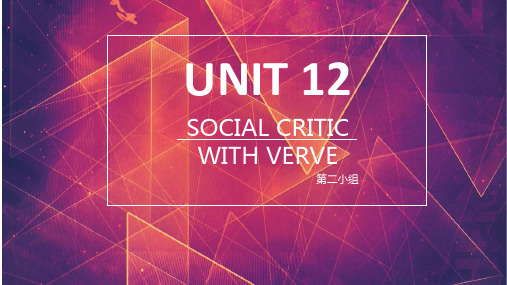
prestigious: adj.受尊敬的,有声望的; celebrated: adj.有名的,著名的 v.庆祝,庆贺 juggled: v.尽力同时应付(两个或两个以上的重要工作 或活动)
Illness as Metaphor
《疾病的隐喻》
The Benefactor
《恩主》
The Volcano Lover is an historical novel by Susan Sontag, published in 1992. Set largely in Naples, it focuses upon Emma Hamilton, her marriage to Sir William Hamilton, the scandal relating to her affair with Lord Nelson, her abandonment, and her descent into poverty. The title comes from William Hamilton's interest in volcanos, and his investigations of Mount Vesuvius.
Yes,Intellectual and celebrity. (P20 Unlike most serious intellectuals, Ms. Sontag was also a celebrity.)
And then we will learn my part from these two words. I will show you my structure.
如何教英语第12章读后感
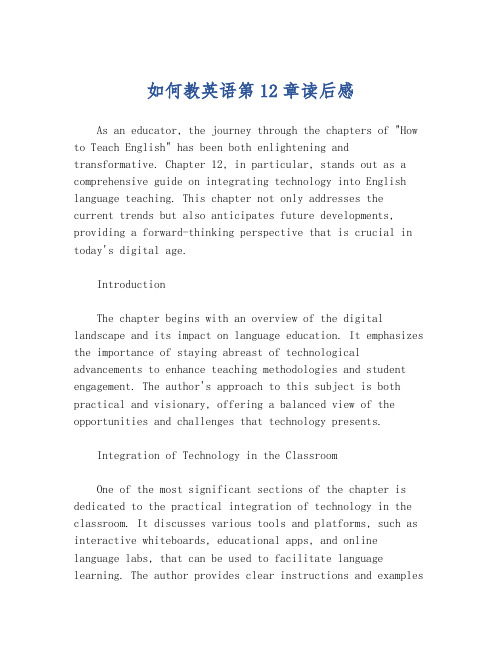
如何教英语第12章读后感As an educator, the journey through the chapters of "How to Teach English" has been both enlightening and transformative. Chapter 12, in particular, stands out as a comprehensive guide on integrating technology into English language teaching. This chapter not only addresses the current trends but also anticipates future developments, providing a forward-thinking perspective that is crucial in today's digital age.IntroductionThe chapter begins with an overview of the digital landscape and its impact on language education. It emphasizes the importance of staying abreast of technological advancements to enhance teaching methodologies and student engagement. The author's approach to this subject is both practical and visionary, offering a balanced view of the opportunities and challenges that technology presents.Integration of Technology in the ClassroomOne of the most significant sections of the chapter is dedicated to the practical integration of technology in the classroom. It discusses various tools and platforms, such as interactive whiteboards, educational apps, and online language labs, that can be used to facilitate language learning. The author provides clear instructions and exampleson how to use these tools effectively, ensuring that they are accessible to teachers at different levels of technological proficiency.Benefits and ChallengesThe chapter also delves into the benefits and challenges of using technology in language teaching. It highlights how technology can personalize learning, provide immediate feedback, and offer a wealth of resources that were previously unavailable. However, it also candidly addresses the potential pitfalls, such as the digital divide, the risk of information overload, and the need for teachers to continuously update their skills.Strategies for Effective UseThe author offers several strategies for the effective use of technology in language teaching. These include setting clear objectives, ensuring that technology supports rather than distracts from learning, and maintaining a balance between online and offline activities. The chapter also stresses the importance of fostering digital literacy among students, equipping them with the skills necessary to navigate the digital world safely and responsibly.Professional DevelopmentRecognizing that teachers are the key to successful technology integration, the chapter devotes a section to professional development. It encourages teachers to engage incontinuous learning, to experiment with new tools, and to share their experiences with colleagues. The author also provides resources for further reading and professional networks that can support teachers in their journey.Reflection on Personal ExperienceReflecting on my own experience after reading this chapter, I realized the profound impact that technology has had on my teaching practice. I have incorporated several of the strategies mentioned, such as using educational apps for vocabulary building and employing online platforms for peer-to-peer communication among my students. The chapter has also challenged me to think critically about the role of technology in fostering a love for language learning rather than merely relying on it as a tool for instruction.ConclusionIn conclusion, Chapter 12 of "How to Teach English" is an invaluable resource for any educator looking to integrate technology into their English language teaching. It provides a comprehensive, thoughtful, and practical guide that can help teachers navigate the complex world of educational technology. The chapter's emphasis on balance, strategy, and continuous professional development is particularly noteworthy, offering a roadmap for teachers to not only keep up with technological advancements but also to leverage them effectively in the service of language education.As I close this reflection, I am reminded of the author'sfinal words, which serve as a call to action for all educators: "Technology is not an end in itself but a means to an end. The end is better language teaching and moreeffective language learning." With this chapter as a guide, I am more confident and better equipped to achieve that end.。
国外认知心理学课件6Chapter12_000
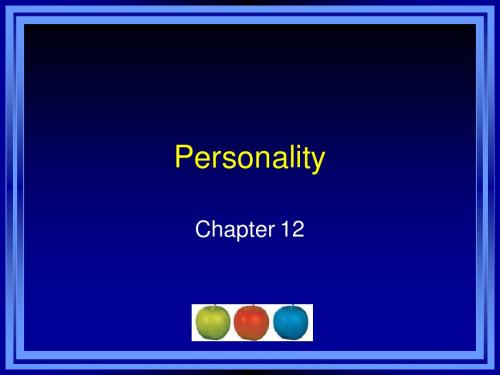
Menu
LO 12.2
Freud’s view of the divisions of the conscious mind
Sigmund Freud
• Founder of the psychoanalytic movement in psychology. • Europe during the Victorian age.
Menu
LO 12.4
Freud’s stages of personality development
Freud’s Theory: Stages of Personality Development
• Phallic stage - third stage occurring from about 3 to 6 years of age, in which the child discovers sexual feelings. Superego develops.
• Anal expulsive personality - a person fixated in the anal stage who is messy, destructive, and hostile. • Anal retentive personality - a person fixated in the anal stage who is neat, fussy, stingy, and stubborn.
Menu
LO 12.4
Freud’s stages of personality development
Freud’s Theory: Stages of Personality Development
• Fixation - disorder in which the person does not fully resolve the conflict in a particular psychosexual stage, resulting in personality traits and behavior associated with that earlier stage. • Psychosexual stages - five stages of personality development proposed by Freud and tied to the sexual development of the child.
新理念大学英语阅读教程unit12 entropy

新理念大学英语阅读教程unit12 entropy EntropyIt was about two months ago when I realized that entropy was getting the better of me. On the same day my car broke down (again), myrefrigerator conked out and I learned that I needed root-canal work in my right rear tooth. The windows in the bedroom were still leaking every time it rained and my son’s baby sitter was still failing to show up everytime I really needed her. My hair was turning gray and my typewriter was wearing out. The house needed paint and I needed glasses. My son’s sneakers were developing holes and I was developing a deep sense of futility.After all, what was the point of spending half of Saturday at the Laundromat if the clothes were dirty all over again the following Friday?Disorder, alas, is the natural order of things in the universe.There is even a precise measure of the amount of disorder, called entropy. Unlike almost every other physical property (motion, gravity, energy), entropydoes not work both ways. It can only increase. Once i t’s created it can never be destroyed. The road to disorder is a one-way street. (entropy的特性)Because of its unnerving irreversibility, entropy has been calledthearrow of time. We all understand this instinctively. Children’s rooms, left on their own, tend to get messy, not neat. Wood rots, metal rusts, people wrinkle and flowers wither. Even mountains wear down; even the nucleiof atoms decay. In the city we see entropy in the rundown subways and worn-out sidewalks and torn-down buildings, in the increasing disorder of our lives. We know, without asking, what is old. If we were suddenly to see the paint jump back on an old building, we would know that something was wrong. If we saw an egg unscramble itself and jump back into its shell, we would laugh in the same way we laugh at a movie run backward. (注意本段的一系列动词) (entropy是什么,为什么被称作时光之箭?)Entropy is no laughing matter, however, because with every increase in entropy energy is wasted and opportunity is lost. Water flowing down a mountainside can be made to do some useful work on its way. But once all the water is at the same level it can work no more. That is entropy. When my refrigerator was working, it kept all the cold air ordered in one part of the kitchen and warmer air in another. Once it broke down the warm and cold mixed into a lukewarm mess that allowed my butter to melt, my milk to rot and my frozen vegetables to decay. (注意本段的一系列动词) (entropy是什么)Of course the energy is not really lost, but it has diffused anddissipated into a chaotic caldron of randomness that can do us no possible good. Entropy is chaos. It is loss of purpose. (entropy是什么) People are often upset by the entropy they seem to see in the haphazardness of their own lives. Buffeted about like so many molecules in my tepid kitchen, they feel that they have lost their sense of direction,that they are wasting youth and opportunity at every turn. It iseasy to see entropy in marriages, when the partners are too preoccupied to patch small things up, almost guaranteeing that they will fall apart. There is much entropy in the state of our country, in the relationships between nations—lost opportunities to stop the avalanche of disorders that seems ready to swallow us all.Entropy is not inevitable everywhere, however. Crystals andsnowflakes and galaxies are islands of incredibly ordered beauty in the midst of random events. If it was not for exceptions to entropy, the sky would be black and we would be able to see where the stars spend their days; it is only because air molecules in the atmosphere clusterin ordered groups that the sky is blue.The most profound exception to entropy is the creation of life. A seed soaks up some soil and some carbon and some sunshine and some water and arranges it into a rose. A seed in the womb takes some oxygen and pizza and milk and transforms it into a baby.The catch is that it takes a lot of energy to produce a baby. Italso takes energy to make a tree. The road to disorder is all downhill but the road to creation takes work. Though combating entropy is possible, italso has its price. That’s why it seems so hard to get ourselves together, so easy to let ourselves fall apart.Worse, creating order in one corner of the universe always creates more disorder somewhere else. We create ordered energy from oil and coal at the price of the entropy of smog.I recently took up playing the flute again after an absence of several months. As the uneven vibrations screeched through the house, my soncovered his ears and said, “Mom, what’s wrong with your flute?” Nothing was wrong with my flute, of course. It was my ability to play it that had atrophied, or entropied, as the case may be. The only way to stop that process was to practice every day, and sure enough my tone improved, though only at the price of constant work. Like anything else, abilities deteriorate when we stop applying our energies to them.That’s why entropy is depressing. It seems as if just breaking even is an uphill fight. There’s a good reason that this should be so. The mechanics of entropy are a matter of chance. Take any ice-cold air molecule milling around my kitchen. The chances that it will wander in the direction of my refrigerator at any point are exactly 50-50. The chances that it will wander away from my refrigerator are also 50-50.But take billions of warm and cold molecules mixed together, and the chances that all the cold ones will wander toward the refrigerator and all the warm ones will wander away from it are virtually nil.Entropy wins not because order is impossible but because there are always so many more paths toward disorder than toward order. There are so many more different ways to do a sloppy job than a good one, so many more ways to make a mess than to clean it up. The obstacles and accidents in our lives almost guarantee that constant collisions will bounce us on to random paths, get us off the track. Disorder is the path of least resistance, the easy but not the inevitable road.Like so many others, I am distressed by the entropy I see around me today. I am afraid of the randomness of international events, of the lack of common purpose in the world; I am terrified that it will lead into the ultimate entropy of nuclear war. I am upset that I could not in the city where I live send my child to a public school; that people are unemployed and inflation is out of control ; that tensions between sexes and races seem to be increasing again; that relationships everywhere seem to be falling apart.Social institutions—like atoms and stars—decay if energy is not added to keep them ordered. Friendships and families and economiesall fall apart unless we constantly make an effort to keep them working and well oiled . And far too few people, it seems to me, are willing to contribute consistently to those efforts.Of course, the more complex things are, the harder it is. If there were only a dozen or so air molecules in my kitchen, it would be likely—ifI waited a year or so—that at some point the six coldest ones wouldcongregate inside the freezer. But the more factors in the equation—themore players in the game—the less likely it is that their pathswillcoincide in an orderly way. The more pieces in the puzzle, theharder it isto put back together once order is disturbed. “Irreversibility,” said aphysicist, “is the price we pay for complexity.”。
- 1、下载文档前请自行甄别文档内容的完整性,平台不提供额外的编辑、内容补充、找答案等附加服务。
- 2、"仅部分预览"的文档,不可在线预览部分如存在完整性等问题,可反馈申请退款(可完整预览的文档不适用该条件!)。
- 3、如文档侵犯您的权益,请联系客服反馈,我们会尽快为您处理(人工客服工作时间:9:00-18:30)。
Outline
1.The Development of Self 2.Self-identity 3.Social Cognition-Know about others
1.The Development of Self
1.1 Self-awareness [自我意识] 1.2 Private Self:Theory of Mind (ToM)
2.Self-identity
2.2 Construct of self-identity[同一性构建] 1.Erikson’s Perspectives ★现代研究者并不认为青春期的同一性构建过程是一个
“危机”。 ★危机是指自我的突然性剧变。对于一些青年人来说,
同一性发展是痛苦而不安的。但对于大多数人来所, 同一性的形成过程通常是逐渐的、平凡的。
[韩]马拉松 (2005)
Outline
1.The Development of Self 2.Self-identity 3.Social Cognition-Know about others
2.Self-identity
2.1 What is Self-identity? 2.2 Construct of self-identity ★★★ 2.3 The Developmental Trends of Identity
1
1.The Development of Self
1.2 Private Self:Theory of Mind (ToM)
★“自我”包括了公众自我和私人自我: - 公众自我(public self/me):能被他人知晓的自我成分; - 私人自我(private self/me):内部主观的自我成分、外界无
法知晓。 ★当儿童意识到自我是由这两个部分组成是,他们就具
有了“心理理论”(Theory of Mind, ToM)
心理理论:对人类具有心理状态(信念、动机、情 感、意图),以及这种状态导致个体的行为,但他 人常无法知晓的理解。
பைடு நூலகம்
1.The Development of Self
1.2 Private Self:Theory of Mind (ToM)
1.2 Private Self:Theory of Mind (ToM)
2.Origins of a Belief-Desire Theory of Mind(信念-愿望理论
★一旦儿童知道人们会在错误新年的基础 上行动,他们就会利用这一点撒谎或玩 弄其他的骗术。
★如果儿童无法学会洞悉人心,无法认识 到外在表象并不总是反映内心,他们便 难以从自己和他人的行为中活动获得重 要的心理理论,人类社会中复杂的交往 和合作就不存在了。
★当婴儿能作用于环境时,他们注意到不同的结果能够 将他们与其他人或物体区分开来。
1.The Development of Self
1.1 Self-awareness [自我意识]
2.“客我”的自我意识 ★到第二年,婴儿开始建构自我的另一个侧面:“客我”
--把自我看作一个认识和评价的客体。 Q:儿童在多大年龄时知道镜子中的那个人就是自己呢?
★3岁的儿童会回答:“在柜子里找”因为他们认为:信念准确 地反映了现实,而且所有人的信念都是一样的,他们不认 为信念只是对现实的解释,人与人有所不同,也有可能是 错误的。
★4-5岁的儿童会表现出信念-愿望理论:“在蓝色的盒子里 找”。他们明白信念只是事实的心理表征,别人也许没有, 也许不正确。
1.The Development of
★客我(me-self):沉思的观察者(a reflective observer), 把自己看做是通过显示自己不同的特征,而成为知识和 评价的综合体,从多方面来估计、评价。包括所有是自 己独一无二的特点: - 物理特点:外貌、财产; - 心理特征:欲望、态度、信仰和思维方式及人格特点; - 社会特征:社会角色和人际关系。
1.The Development of Self
1.2 Private Self:Theory of Mind (ToM)
2.Origins of a Belief-Desire Theory of Mind(信念-愿望理论 错误信念任务:丽丽有一块巧克力糖,她把它放在一个蓝 色的盒子里,然后出去玩了。丽丽的妈妈走进房间,把糖 取出来放进柜子里面。当丽丽回来时想吃巧克力糖,她会 去哪里找?
Formation 2.4 Factors influencing Identity Formation
2.Self-identity
2.1 What is Self-identity? ★认同感/同一性(identity):成熟的自我定义;
对自己是谁,将要成为什么样,如何适应社会 的感受。
★自我同一性是在应对许多选择中形成的: ◆什么样的职业是我想要的? ◆我该信仰什么宗教、道德和政治价值? ◆作为一个男人或女人,我是谁? ◆茫茫人海中,我的位置在哪里?
[心理理论] ★★
1.The Development of Self
威廉·詹姆斯提出自我可以分成两个方面:
★主我(I-self):主体的我(subject slef),一个独立于其他 人和物,又和其他人发生关系的我。包括:自己是独立 于周围世界的,能回应并能控制周围环境,有别人无法 介入的私人内部世界,并能持久存在;
年期并不是同一性混乱或同一性解决,而是个体在不 同领域(如职业、宗教、关系选择、性别角色等等) 关于自我认同(identity)的探索程度以及对这个认同的 接受程度[责任(committment)]。
★个体的同一性知觉主要取决于个体在特定的人格和社 会特质上所做的选择(choices)和接受程度(committment) - how much one has made certain choices?(他/她是怎样 作出某种选择的?) - how much he or she displays a commitment to those choices? (他/她对这些选择的接受程度如何)
2.Self-identity
2.2 Construct of self-identity[同一性构建]
1.Erikson’s Perspectives ★同一性是埃里克森最早提出的,他认为:
◆同一性是青少年人格发展的重要方面,也是想成为一 个快乐的成年人的至关重要的一步;
◆婴儿期和儿童期成功的社会心理因素将有助于形成积 极的同一性;
◆尽管同一性的种子很早就根植于儿童心里,但青春期 甚至成年后才表现出来;
3
2.Self-identity
2.2 Construct of self-identity[同一性构建]
1.Erikson’s Perspectives ★同一性是埃里克森最早提出的,他认为:
◆儿童在进入青春期后会经历一个同一性危机。 ◆在同一性危机中: - 青少年对他们原来认为理所当然的事情开始质疑, 通过内在灵魂的探讨的青年人最终达到成熟。 - 对儿童期描述的自我特质进行筛选,并在儿童期的 自我定义中加入新的内容,并把这些东西综合成一个 内在的核心。 同一性危机(identity crisis):对现在和将来在生活中的角 色感到混乱,从而体验到的不确定性和不适应。
Q:你目前正在经历“同一性危机”吗?
2.Self-identity
2.2 Construct of self-identity[同一性构建]
2.Marcia’s perspecitves of Self-identity statuses ★加拿大发展心理学家马西亚(James Marcia,1990)认为青少
2.沟通方面: ◆语言发展迟缓和有障碍,说话内容,速度,及音调异常; ◆对语言理解和非语言沟通有不同程度的困难; ◆可能欠缺口语沟通的能力。
3.行为方面: ◆在日常生活中,坚持某些行事方式和程序,拒绝改变习惯和常
规,并且不断重复一些动作; ◆兴趣狭窄,会极度专著于某些物件,或对物件的某些部分或某些
特定形状的物体特别感兴趣。
1.The Development of Self
1.2 Private Self:Theory of Mind (ToM)
2.Origins of a Belief-Desire Theory of Mind(信念-愿望理论 自闭症(autism)有关的电影
阿斯伯格症 候群综合征
[英]莫扎特和鲸 鱼(2005)
1.The Development of Self
1.1 Self-awareness [自我意识]
1.“主我”的自我意识 ★儿童最早萌发的自己的概念是“主我”--对作为主体
的我,或行为发出者的意识.
★许多研究者认为,当婴儿能认识到,自己可以使物体 或他人以某种可预测的方式发生反应时,他们的主我 就开始逐渐出现了。
★年幼的儿童之所以认为愿望是决定行为的重要因素, 是因为他们自己的行为往往是由愿望驱动,从而认为 他人的行为也反映了同样的动机。
愿望理论(desire theory):认为个体的行为反映了他 的愿望,而没有认识到人的其他心理状态(如信念) 也会影响行为(Cassidy, 1998; Wellman & Woolley, 1990)。
研究发现:把9-24个月的儿童放在镜子前, 每位母亲在婴儿不注意的情况下,在他们的 鼻子上涂上红色颜料。小的婴儿会去摸镜子 里的红鼻子,好像镜子里的红鼻子和他们无 关。到15个月时,他们开始擦自己的红鼻子。 这个反应表明他们具有对自己独特形象的敏 锐意识(Lewis & Brooks-Gunn, 1979)
2.Self-identity
2.2 Construct of self-identity[同一性构建]
